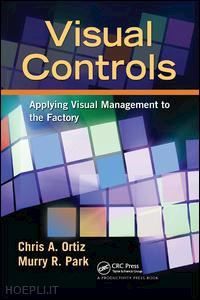Introduction, Acknowledgments, Chapter 1 Importance of the Visual Factory, The Common Ground of Production Environments, People, Processes, Time, Human Interfaces, Engineering Changes, Expediting, and Nonconforming Product, Inventory, Raw Materials, WIP Levels, Finished Goods, The Bottom Line—Making Information Accessible, Management’s Role, The Basics of the Visual Factory: 5S, Visual Factory Layout, Visual Tools, Visual Parts and Supplies, Visual Maintenance and Total Productive Maintenance Boards, Visual Communication, Chapter 2 The Basics of the Visual Factory: 5S, The 5S’s, Sort, Set in Order, Shine or Scrub, Standardize, Sustain, Let the 5S Event Begin, 5S Day 1: Sort, Sorting Team, 5S Day 2 and Day 3: Set in Order and Shine, Position Floor Items, Create an Addressing System, Organize Tools and Supplies, Tool Board Basics, Shine and Scrub, 5S Day 4: Standardize, 5S Day 5: Beginning to Sustain, 5S in Maintenance Departments, Tips for Sustaining 5S, Create an End-of-Day Clean-Up Procedure, Conduct a Daily or Shift Walkthrough, Establish a 5S Audit Sheet, Create and Maintain a 5S Tracking Sheet, Develop a 5S Incentive Program, Chapter 3 Visual Factory Layout, The Legacy of Factory Layouts, Visualizing Your Visual Factory, Actualizing Your Visual Factory, General Guidelines, Addressing Waste when Planning the Visual Factory, Overproduction, Waiting, Motion, Overprocessing, Transportation, Excess Inventory, Rejects and Scrap, Overall Sequence for Creating a Visual Factory Layout, The Four Basic Conditions of Value-Adding Processes, Value Is Being Added, Process Is Being Reconfigured (Setup or Changeover), Planned Stoppage, Unplanned Stoppage, Visual Inventory, Feed Materials and Consumables, Purchased Inventory, WIP, Finished Goods, Laying Out Support Functions, Common Area, Direct Support Functions, Supervisory Personnel, Maintenance, Tooling, QA, Planning, Indirect Support Functions, Materials Supply, Manufacturing Engineering, Production Management, Product Engineering, Safety and Environmental Functions, Finance, Plant Management, Sales, Office Support Personnel, Overall Support Services, Back to Your Future Factory Layout, Chapter 4 Visual Tools, Visual Tool Boards or Shadow Boards, Tool Board Materials, Designing and Constructing a Tool Board, Personal Tools: Dilemma or Solution?, Tool Check Cards, Positioning Tools Overhead, Right-Sizing, Chapter 5 Visual Parts and Supplies, Inventory Basics, When We Use the Term, What Specifically Are We Talking About?, Why Is Having More Inventory than What Is Needed to Support Customer Demand a Bad Thing?, Why Does Your Company Carry Its Existing Levels of Inventory?, Is It Possible to Drive Down Inventory Levels without Putting Production and Shipping Commitments in Jeopardy?, What Role Does a Visual Management System Play in Achieving a Reduced Inventory Level?, A Few General Points on Supply Chain Management, The Role of Manufacturing Software Systems, Current Global Trends, Receiving Inspection, A Tour through the Ideal Stockroom, Materials Common Area, Stockroom Entrance, Unloading Dock, Receiving Inspection Area, Main Stockroom, Stockroom Layout Considerations, Factory Destination, Size and Weight, Demand Volume, Inventory Reduction Strategy, 5S and Kanban, 5S in the Stockroom, Incoming Parts Staging, Receiving Inspection, Supplies and Tools Area, Parts for Production, Replenishment: Kanban and Two-Bin Systems, Setting Up a Kanban System, Two-Bin Systems, Parts Bins and Color-Coded Labels, Two-Bin Team Exercise, Chapter 6 Visual Maintenance and Total Productive Maintenance Boards, The Role of Maintenance, Common Misconceptions, First Responder, Impact of Product Nonconformities, Total Productive Maintenance—An Overview, The Three Approaches to TPM, Proactive Maintenance, Preventive Maintenance, Predictive Maintenance, The Three Levels of TPM, TPM Level 1: Operators, TPM Level 2: Maintenance Technicians, TPM Level 3: Equipment Suppliers, Implementing TPM and TPM Visuals, Cross-Training, Visual Layout for the Maintenance Area, Creating a Common Area, Tools, Equipment, and Consumables Storage, Measurement and Calibration Equipment, Common Area Layout, Maintenance Layout on the Production Floor, Maintenance 5S, Visual Tool Boards, Personal Tools, Name Tags, Maintenance Consumables and Kanban, Overall Equipment Effectiveness, The Maintenance Manager, Chapter 7 Visual Communications, Facility Performance, Sales, On-Time Delivery, Productivity, Quality, Safety, Environmental, Metrics Communication Boards at the Production Level, Production Control Boards, Communication Lights, Lean Procedures, Conclusion, Glossary, Index, About the Authors











